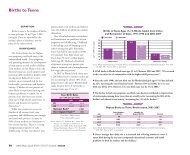2010 Rhode Island Kids Count Factbook
2010 Rhode Island Kids Count Factbook
2010 Rhode Island Kids Count Factbook
Create successful ePaper yourself
Turn your PDF publications into a flip-book with our unique Google optimized e-Paper software.
10<br />
12.2<br />
11.7<br />
Infant Mortality<br />
8<br />
6<br />
4<br />
6.9<br />
7.4<br />
8.2<br />
7.4<br />
5.9 5.8<br />
6.4 6.4<br />
2<br />
0<br />
Black Asian Hispanic White All Races<br />
DEFINITION<br />
Infant mortality is the number of<br />
deaths of infants under one year of age<br />
per 1,000 live births. The data are<br />
reported by place of mother’s residence,<br />
not place of infant’s birth.<br />
SIGNIFICANCE<br />
Infant mortality rates are associated<br />
with maternal health, quality of and<br />
access to medical care, socio-economic<br />
conditions, and public health practices. 1<br />
Communities with multiple problems<br />
such as poverty, unemployment and low<br />
literacy levels tend to have higher infant<br />
mortality rates than more advantaged<br />
communities. 2<br />
The two chief causes of infant death<br />
are birthweights of less than 750 grams<br />
and prematurity. 3 Other leading causes<br />
of infant death include congenital<br />
abnormalities and malformations,<br />
Sudden Infant Death Syndrome<br />
(SIDS), maternal complications, and<br />
unintentional injuries. 4 Nationwide,<br />
approximately 20% of infant deaths are<br />
attributed to birth defects, compared<br />
with 14% in <strong>Rhode</strong> <strong>Island</strong>. The<br />
majority of birth defects affect the<br />
cardiovascular system. 5<br />
The U.S. infant mortality rate fell<br />
from 26.0 deaths per 1,000 live births<br />
in 1960 to 6.9 deaths per 1,000 live<br />
births in 2000, a decrease due to<br />
improvements in sanitary conditions,<br />
antibiotics, and health care access for<br />
low-income families. The U.S. has<br />
higher infant mortality rates than other<br />
industrialized countries, due in large<br />
part to disparities among various racial<br />
and ethnic groups, particularly for<br />
African Americans. 6 Between 1990 and<br />
2007, the infant mortality rate among<br />
African Americans remained at more<br />
than twice the national average. 7<br />
Risk factors for infant mortality<br />
include delayed or no prenatal care,<br />
smoking during pregnancy, pregnancies<br />
involving more than one fetus, maternal<br />
age over 40 or under 20 at the time of<br />
birth, having low education levels, and<br />
being unmarried. 8<br />
The overall infant mortality rate in<br />
<strong>Rhode</strong> <strong>Island</strong> between 2004 and 2008<br />
was 6.2 deaths per 1,000 live births.<br />
The infant mortality rate was 55%<br />
higher in the core cities than in the<br />
remainder of the state. 9<br />
Infant Mortality Rate<br />
(rate per 1,000 live births)<br />
2000 2006<br />
RI 6.3 6.1<br />
US 6.9 6.7<br />
National Rank* 17th<br />
New England Rank** 3rd<br />
*1st is best; 50th is worst<br />
**1st is best; 6th is worst<br />
Source: 2009 KIDS COUNT data book: State profiles in<br />
child well-being 2009. (2009). Baltimore, MD: The<br />
Annie E. Casey Foundation.<br />
Infant Mortality by Birthweight, <strong>Rhode</strong> <strong>Island</strong>, 2004-2008<br />
11%<br />
22%<br />
2%<br />
25%<br />
39%<br />
39% < 500 grams ( 2,500 grams (> 5lbs., 8oz.)<br />
2% Unknown<br />
n=385<br />
Source: <strong>Rhode</strong> <strong>Island</strong> Department of Health, Center for Health Data and Analysis, Maternal and Child Health Database,<br />
2004-2008. Data for births in 2007 and 2008 are provisional. Data for deaths in 2008 are provisional. Percentages<br />
may not sum to 100% due to rounding.<br />
◆ Between 2004 and 2008, 385 infants died in <strong>Rhode</strong> <strong>Island</strong> before their first birthday.<br />
Seventy-six percent of infants who died during this time period were low birthweight,<br />
22% were born at normal weights and 2% had unknown birthweights. 10<br />
◆ Of the 385 infant deaths between 2004 and 2008 in <strong>Rhode</strong> <strong>Island</strong>, 295 (77%)<br />
occurred in the neonatal period (during the first 27 days of life). 11 Neonatal mortality is<br />
generally related to short gestation and low birthweight (less than 2,500 grams),<br />
malformations at birth and/or conditions occurring in the perinatal period. 12<br />
◆ Between 2004 and 2008, 90 (23%) of the 385 infant deaths in <strong>Rhode</strong> <strong>Island</strong> occurred<br />
in the post-neonatal period (between 28 days and one year after delivery). 13 Nationally,<br />
most of the progress in reducing the rate of infant mortality has resulted from improving<br />
outcomes during the post-neonatal period. 14<br />
◆ In <strong>Rhode</strong> <strong>Island</strong> between 2004 and 2008, the Black infant mortality rate was 12.1<br />
deaths per 1,000 live births, the Asian infant mortality rate was 6.2 per 1,000 live births<br />
and the Native American infant mortality rate was 9.3 per 1,000 live births. All minority<br />
groups had infant mortality rates greater than the rate for White infants (5.4 per 1,000<br />
births). The Hispanic infant mortality rate was 8.2 per 1,000 live births compared with<br />
7.1 deaths per 1,000 live births among non-Hispanics in <strong>Rhode</strong> <strong>Island</strong>.* 15<br />
◆ Preterm births are a major determinant of infant mortality in the U.S. In <strong>Rhode</strong> <strong>Island</strong><br />
between 2004 and 2008 there were 7,418 preterm births (11.9% of all births). 16<br />
70 <strong>2010</strong> <strong>Rhode</strong> <strong>Island</strong> KIDS COUNT <strong>Factbook</strong> / Health






